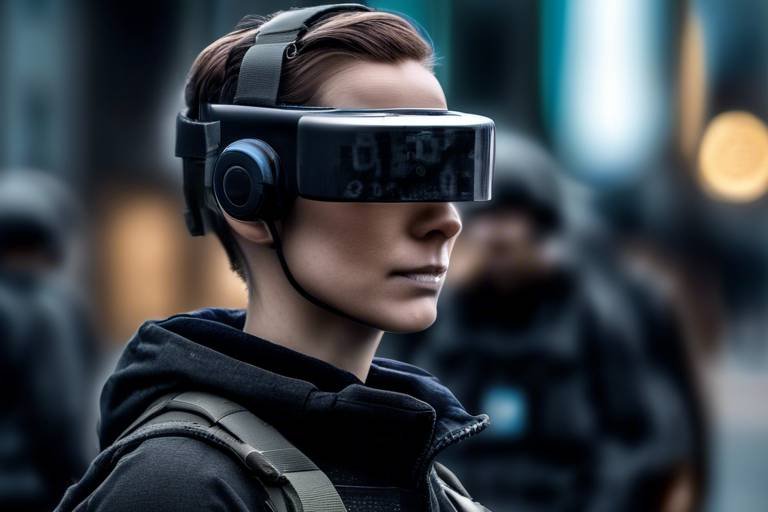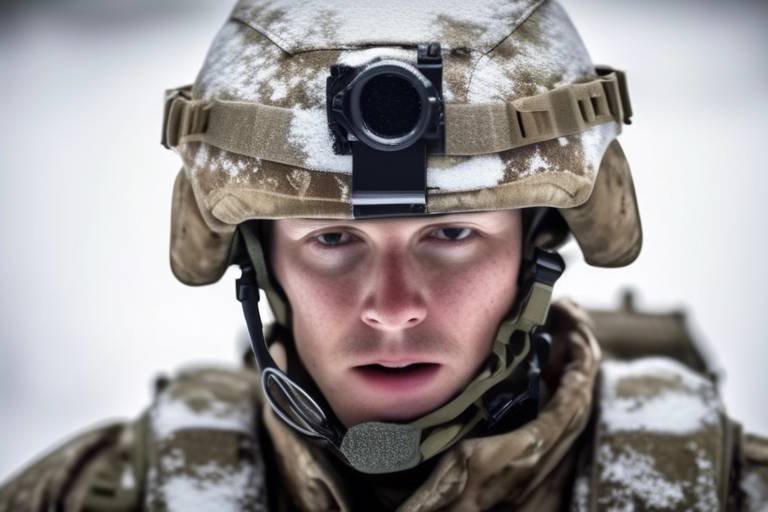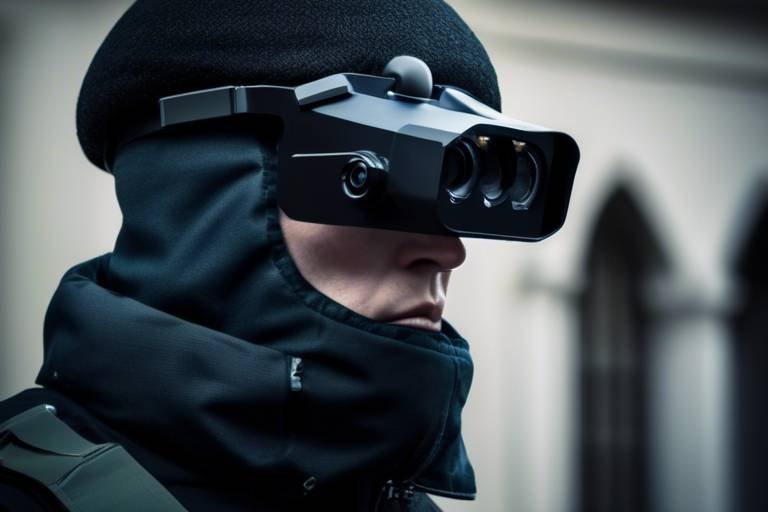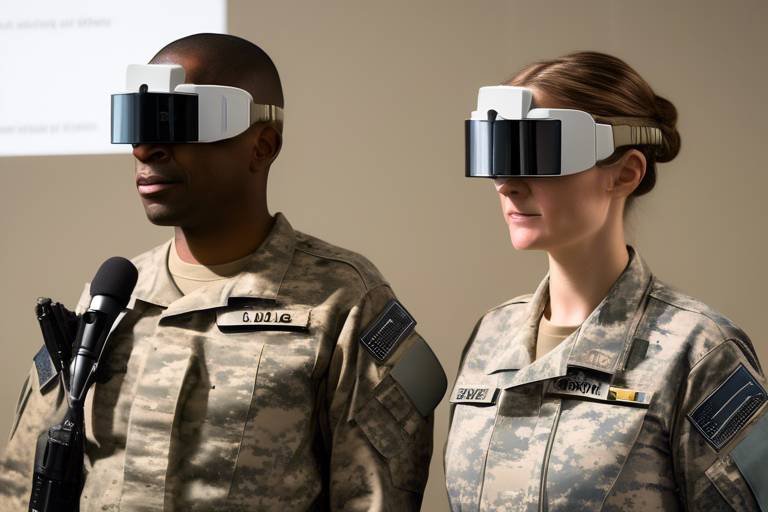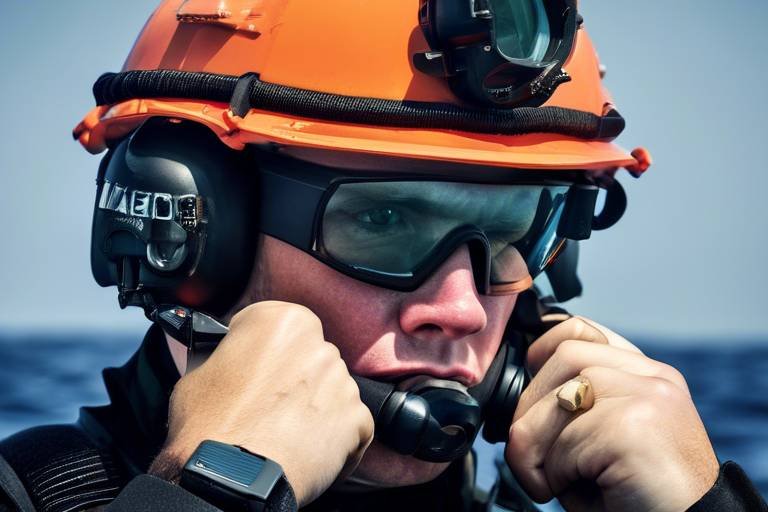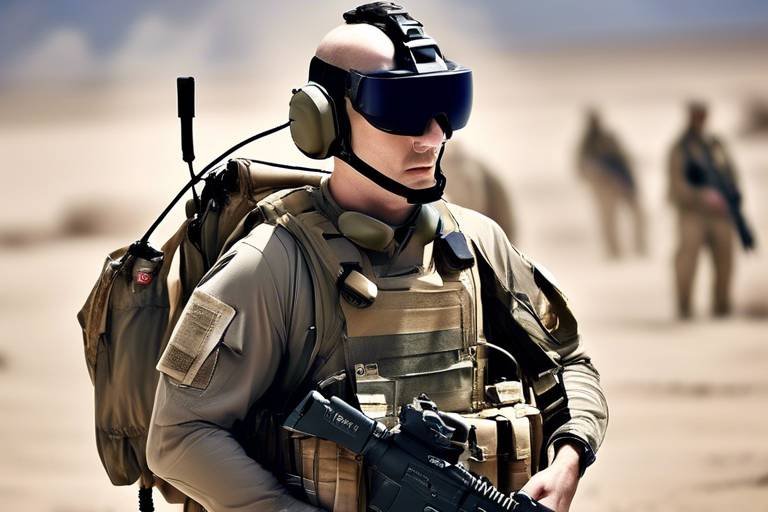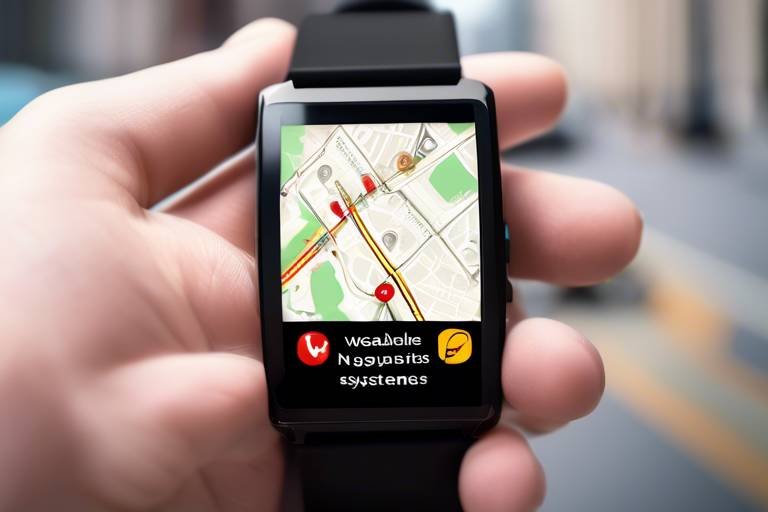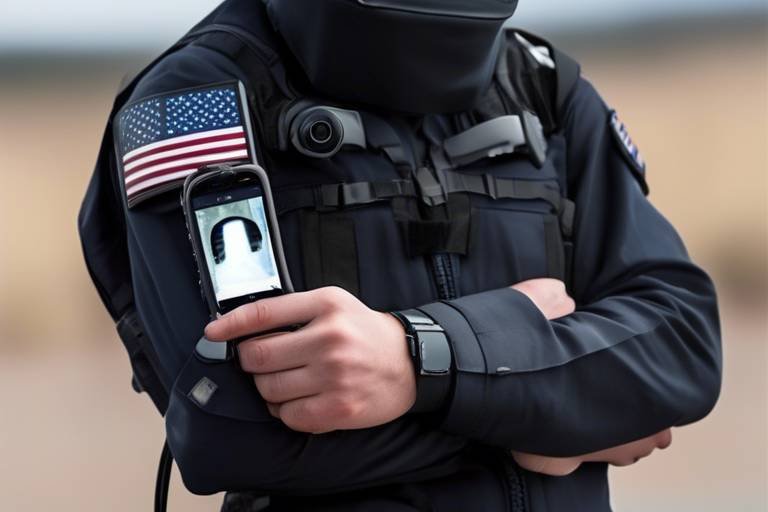How Smart Wearables Are Supporting Psychological Operations
In a world where technology is evolving at breakneck speed, smart wearables are emerging as game-changers, particularly in the realm of psychological operations. These devices, once limited to tracking fitness metrics, have transformed into sophisticated tools that can monitor and analyze mental health indicators in real-time. Imagine a soldier on the battlefield wearing a device that not only tracks their heart rate but also gauges their stress levels and emotional state. This integration of technology into psychological operations is not just a trend; it's a revolution that is reshaping how we understand and manage mental health in both military and civilian contexts.
The potential of smart wearables extends far beyond simple data collection. They offer a new lens through which we can view psychological well-being, allowing for proactive measures rather than reactive responses. With features that can detect fluctuations in mood or stress, these devices empower individuals and teams to take charge of their mental health, fostering resilience and enhancing overall performance. As we delve deeper into this topic, we will explore how smart wearables are being utilized, the benefits they bring, and the implications for the future.
Smart wearables have come a long way from their inception as basic fitness trackers. Initially designed to count steps and monitor heart rates, they have evolved into multifaceted devices capable of tracking a range of physiological and psychological indicators. Today, these wearables can measure variables such as sleep patterns, stress levels, and even emotional responses. This evolution signifies a shift in focus from mere physical health to a more holistic understanding of well-being.
As technology continues to advance, the capabilities of these devices will only expand. They are now equipped with sensors that can detect changes in skin temperature, heart rate variability, and even galvanic skin response, providing a comprehensive picture of an individual’s mental state. This data can be invaluable in high-stress environments, allowing for timely interventions and support.
In military contexts, the application of smart wearables is particularly crucial. These devices are being employed to assess soldiers' mental states, which can significantly enhance decision-making and operational effectiveness. Imagine a scenario where commanders can receive real-time updates on the mental well-being of their troops. This capability not only helps in maintaining troop readiness but also plays a vital role in minimizing psychological stress during missions.
One of the standout features of smart wearables is their ability to facilitate real-time data collection. By continuously monitoring physiological data, commanders can make informed decisions about troop readiness and mental health. This is especially important in high-stress environments where the stakes are high, and the margin for error is slim. The ability to assess mental health on the fly can mean the difference between success and failure in critical operations.
Many smart wearables now come equipped with advanced stress monitoring features. These capabilities provide insights into soldiers' mental well-being, enabling timely interventions to prevent burnout or psychological crises. For instance, if a soldier's stress levels spike during a mission, the wearable can alert both the individual and their commanding officer, allowing for immediate support. This proactive approach is essential in maintaining not only the effectiveness of the unit but also the overall mental health of the soldiers.
Furthermore, smart wearables serve as enhanced communication tools. They allow for seamless information sharing among team members, fostering a supportive environment during operations. Imagine soldiers being able to communicate their mental state through their devices without needing to verbally express it, thus reducing the stigma often associated with discussing mental health in high-pressure situations.
Beyond military use, smart wearables are increasingly being integrated into civilian psychological operations. These devices are aiding in mental health initiatives and community support programs, providing individuals with the tools they need to monitor and manage their mental health effectively. The accessibility of these devices means that more people can benefit from the insights they provide, leading to a broader cultural shift toward mental health awareness and support.
The integration of smart wearables in psychological operations offers numerous benefits. Not only do they improve mental health monitoring, but they also enhance situational awareness and increase engagement in wellness programs. The continuous monitoring of mental health indicators allows for early detection of issues, which can lead to timely interventions and significantly improve overall well-being.
Wearables provide continuous monitoring of mental health indicators, allowing for early detection of issues and timely interventions. This capability can be a game-changer for many individuals, as it shifts the focus from reactive care to proactive management of mental health. By keeping track of their mental state, users can take action before issues escalate, leading to a healthier, more balanced life.
Moreover, smart wearables promote greater participation in wellness programs through gamification and social connectivity. By making mental health tracking engaging and interactive, these devices foster a culture of mental health awareness and support. Users are more likely to engage in wellness activities when they can see their progress and share their achievements with others.
- What are smart wearables? Smart wearables are electronic devices worn on the body that can monitor various health metrics, including physical and mental health indicators.
- How do smart wearables help in psychological operations? They provide real-time data on mental health, enabling timely interventions and fostering a supportive environment.
- Can smart wearables be used in civilian contexts? Yes, they are increasingly being used in civilian mental health initiatives and community support programs.
The Evolution of Smart Wearables
Smart wearables have undergone a remarkable transformation over the past decade. Initially, these devices were primarily focused on tracking physical activity, such as counting steps or monitoring heart rates. However, as technology has advanced, so too has the functionality of these devices. Today, smart wearables are capable of monitoring a variety of health indicators, including mental health metrics, providing real-time data that is essential for both military and civilian psychological operations.
The journey of smart wearables can be likened to the evolution of smartphones. Just as smartphones transitioned from simple communication tools to comprehensive devices that manage our daily lives, smart wearables have expanded their capabilities beyond basic fitness tracking. They now incorporate sophisticated sensors and algorithms that can analyze a wearer’s physiological responses to stress, anxiety, and other emotional states.
For instance, many modern wearables are equipped with features such as heart rate variability (HRV) monitoring, sleep tracking, and even electrodermal activity (EDA) sensors, which measure the electrical conductance of the skin—a key indicator of stress. This data can be invaluable in understanding a person's psychological state. In fact, a study by the Journal of Medical Internet Research found that wearables could predict anxiety levels with a high degree of accuracy.
As these devices continue to evolve, they are becoming more user-friendly and accessible. The integration of artificial intelligence (AI) and machine learning allows wearables to provide personalized feedback and recommendations based on individual data. This means that users can receive tailored insights into their mental health, helping them to manage stress and anxiety more effectively.
Moreover, the rise of mobile applications has further enhanced the functionality of smart wearables. Users can now sync their devices with apps that not only track physical activity but also offer mental health resources, mindfulness exercises, and community support. This interconnectedness fosters a holistic approach to health—one that encompasses both physical and psychological well-being.
In summary, the evolution of smart wearables reflects a broader trend towards comprehensive health monitoring. As we continue to embrace these technologies, their potential to support psychological operations—whether in military settings or civilian life—becomes increasingly evident. The future of smart wearables is bright, promising innovative solutions that can enhance our understanding of mental health and improve overall quality of life.
Applications in Military Operations
In the realm of military operations, the integration of smart wearables has ushered in a new era of psychological support for soldiers. These devices go beyond mere fitness tracking; they are becoming essential tools for monitoring the mental and emotional states of personnel during high-stress missions. Imagine a soldier on the front lines, equipped not just with weapons but with a device that can gauge their stress levels and provide real-time feedback. This transformation is not just a technological advancement; it’s a game changer for operational effectiveness.
One of the most significant applications of smart wearables in military contexts is their ability to facilitate real-time data collection. These devices can monitor various physiological indicators such as heart rate, sleep patterns, and even galvanic skin response, which can all signal a soldier's mental state. By analyzing this data, commanders can make informed decisions regarding troop readiness. For instance, if a soldier's stress levels are consistently high, it may signal the need for a break or additional support. This proactive approach can prevent crises before they escalate, ensuring that soldiers remain effective and focused.
Furthermore, the capability of smart wearables to collect real-time data is crucial in high-stress environments. Commanders can access this information instantaneously, providing a clear picture of the mental landscape of their troops. This data-driven approach allows for adjustments to be made on the fly, ensuring that soldiers are not only physically prepared but also mentally fit for the challenges they face. It’s like having a dashboard that displays not just the fuel levels of a vehicle but also the emotional readiness of its driver.
Many modern smart wearables come equipped with stress monitoring features. These capabilities are invaluable in assessing soldiers' mental well-being. For example, if a wearable detects elevated stress levels, it can alert both the soldier and their commanding officer, enabling timely interventions. This could involve a simple check-in, a brief period of rest, or even access to a mental health professional. The goal is to prevent burnout or psychological crises, which can severely impact operational effectiveness. By addressing mental health proactively, military operations can maintain a high level of performance without sacrificing the well-being of their personnel.
In addition to monitoring capabilities, smart wearables serve as enhanced communication tools. They allow for seamless information sharing among team members, which is particularly important during operations where every second counts. Imagine a scenario where a soldier can instantly relay their mental state to a commanding officer or receive vital information about their teammates' well-being. This fosters a supportive environment, where soldiers feel connected and understood, even in the most isolated conditions. The power of communication through these devices cannot be overstated; it creates a sense of camaraderie and collective resilience.
In summary, the applications of smart wearables in military operations are vast and impactful. They not only enhance decision-making and operational effectiveness but also prioritize the mental health of soldiers. By leveraging technology, the military can ensure that its personnel are not just equipped for battle but are also supported psychologically, paving the way for a more resilient force.
- What types of smart wearables are used in military operations? Smart wearables used in military operations include fitness trackers, smartwatches, and specialized devices designed for monitoring physiological and psychological indicators.
- How do smart wearables improve mental health monitoring? They provide continuous data on stress levels, sleep quality, and other indicators, allowing for early detection of mental health issues and timely interventions.
- Can smart wearables be used in civilian contexts? Yes, smart wearables are increasingly being utilized in civilian psychological operations, including mental health initiatives and community support programs.
Real-Time Data Collection
In the fast-paced world of military operations, the ability to collect real-time data is nothing short of revolutionary. Smart wearables have stepped up to the plate, offering an unprecedented level of insight into the mental and physical states of soldiers. Imagine being in a high-pressure situation where every second counts, and you have a device that can monitor your heart rate, stress levels, and even emotional responses at a glance. This is not science fiction; it's the reality of modern warfare.
These wearables utilize advanced sensors to capture a variety of physiological indicators that can be crucial for assessing a soldier's readiness and mental health. For instance, metrics like heart rate variability, skin conductance, and even sleep patterns can be monitored continuously. This data not only informs commanders about the physical state of their troops but also provides a window into their psychological well-being. In high-stress environments, where the stakes are incredibly high, having access to such information can be a game changer.
To illustrate the types of data collected, consider the following table:
| Data Type | Description | Significance |
|---|---|---|
| Heart Rate Variability | Measures the variation in time between heartbeats. | Indicates stress levels and overall resilience. |
| Skin Conductance | Measures the electrical conductance of the skin. | Reflects emotional and stress responses. |
| Sleep Patterns | Tracks duration and quality of sleep. | Critical for recovery and mental clarity. |
With the integration of these wearables, commanders can make informed decisions about troop deployment and readiness. For example, if a soldier’s data indicates elevated stress levels or poor sleep quality, a commander might opt to provide additional rest or support before sending them into a critical situation. This proactive approach not only enhances operational effectiveness but also prioritizes the mental health of soldiers, which is often overlooked in traditional military assessments.
Moreover, the ability to collect and analyze this data in real-time fosters a culture of transparency and support within military units. Soldiers can feel more empowered to discuss their mental health, knowing that their well-being is being monitored and taken seriously. This shift from a reactive to a proactive strategy can significantly mitigate the risks of burnout and psychological crises, ultimately leading to a more resilient fighting force.
In conclusion, the integration of real-time data collection through smart wearables is not just a technological advancement; it's a paradigm shift in how we approach mental health in military operations. As we continue to embrace these innovations, we pave the way for a future where mental health is prioritized alongside physical readiness, ensuring that our soldiers are not only prepared for battle but also supported in their psychological well-being.
Stress Monitoring Features
In today's fast-paced world, the importance of mental health cannot be overstated, especially in high-pressure environments such as military operations. Smart wearables have stepped up to the plate, offering that play a crucial role in assessing and managing psychological well-being. These devices are equipped with advanced sensors that track physiological indicators like heart rate variability, skin temperature, and even galvanic skin response. By continuously monitoring these metrics, wearables can provide real-time feedback on a soldier's stress levels, enabling swift interventions when necessary.
Imagine a soldier on the front lines, facing the immense pressure of their duties. With a smart wearable, they can receive alerts if their stress levels spike, prompting them to take a moment to breathe or engage in a quick mindfulness exercise. This capability acts as a safety net, helping to prevent burnout and psychological crises before they escalate. Additionally, these wearables can collect data over time, allowing military psychologists and commanders to identify patterns and trends in stress responses among troops.
Moreover, the integration of stress monitoring features extends beyond mere data collection. Many devices offer personalized feedback and recommendations based on the user's stress patterns. For instance, if a soldier's data indicates elevated stress during a specific time of day or after particular activities, the wearable might suggest relaxation techniques or even a short break. This tailored approach not only empowers individuals to take charge of their mental health but also fosters a culture of awareness and support within military units.
To illustrate the effectiveness of these stress monitoring features, consider the following table that highlights key physiological indicators tracked by smart wearables:
| Physiological Indicator | Significance |
|---|---|
| Heart Rate Variability | Indicates stress levels and emotional resilience |
| Skin Temperature | Can signal changes in stress response |
| Galvanic Skin Response | Measures skin conductivity, reflecting emotional arousal |
In summary, the stress monitoring features of smart wearables not only provide critical insights into the mental health of soldiers but also facilitate timely interventions that can significantly enhance operational effectiveness. By harnessing technology in this way, we are not just equipping our troops with tools for physical endurance, but also nurturing their psychological resilience, ensuring they are prepared for the challenges they face.
- What types of stress indicators do smart wearables track?
Smart wearables typically track indicators like heart rate variability, skin temperature, and galvanic skin response to assess stress levels. - How do stress monitoring features help soldiers?
These features provide real-time feedback on stress levels, enabling timely interventions and promoting mental well-being. - Can smart wearables be used in civilian contexts?
Yes, they are increasingly used in civilian psychological operations and mental health initiatives.
Enhanced Communication Tools
In the fast-paced world of military operations, effective communication can be the difference between success and failure. Smart wearables have emerged as powerful tools that enhance communication among team members, ensuring that vital information flows seamlessly even in high-pressure situations. Imagine a soldier in the field, equipped with a wearable device that not only tracks their physical health but also allows them to communicate with their unit in real-time. This integration of technology transforms traditional communication methods, making them more efficient and reliable.
One of the most significant advantages of smart wearables is their ability to provide instant updates and alerts. For instance, if a soldier experiences a sudden spike in heart rate or displays signs of distress, their device can automatically send an alert to their commanding officer. This real-time data sharing enables commanders to make quick decisions regarding troop welfare and operational adjustments. Additionally, these devices can facilitate group messaging, allowing team members to share critical information or coordinate actions without the need for bulky communication equipment.
Moreover, smart wearables often come equipped with features like GPS tracking and location sharing, which can be invaluable during missions. Commanders can monitor the locations of their personnel, ensuring that everyone is accounted for and can be reached quickly in case of an emergency. This capability not only enhances operational efficiency but also fosters a sense of safety among soldiers, knowing that they can rely on their team for support.
Incorporating voice recognition technology into smart wearables further elevates their communication capabilities. Soldiers can send voice commands or messages without needing to take their hands off their equipment or divert their attention from their surroundings. This hands-free feature is crucial in combat situations where every second counts. Additionally, wearables can be designed to integrate with existing communication systems, providing a more cohesive and streamlined approach to information sharing.
As we look to the future, the potential for smart wearables in enhancing communication is vast. With advancements in artificial intelligence and machine learning, these devices could evolve to offer predictive analytics, identifying potential issues before they escalate. Imagine a scenario where a soldier's device can analyze their stress levels and suggest a brief break or a change in strategy to mitigate potential risks. This proactive approach could revolutionize how teams communicate and operate in the field.
In conclusion, the role of smart wearables as enhanced communication tools cannot be overstated. They not only improve the flow of information but also contribute to the overall mental well-being of soldiers by fostering a supportive environment. With the integration of advanced technologies, the future of communication in military operations looks promising, paving the way for safer and more effective missions.
- What are smart wearables? Smart wearables are electronic devices worn on the body that can monitor various health indicators and facilitate communication.
- How do smart wearables help in military operations? They provide real-time data on soldiers' health, enhance communication, and help commanders make informed decisions.
- Can smart wearables be used in civilian contexts? Yes, they are increasingly being integrated into civilian mental health initiatives and community support programs.
- What benefits do smart wearables offer for mental health? They enable continuous monitoring of mental health indicators and promote engagement in wellness programs.
Impact on Civilian Psychological Operations
The influence of smart wearables extends far beyond the military realm, making significant strides in civilian psychological operations. These devices are revolutionizing the way mental health is monitored and managed in everyday life. Imagine a world where your wristband not only tracks your steps but also keeps an eye on your stress levels, mood swings, and even sleep patterns. This isn't science fiction; it's happening now, and it's changing lives. The integration of smart wearables into mental health initiatives is providing individuals and communities with tools that promote awareness, support, and proactive intervention.
One of the most compelling aspects of smart wearables is their ability to collect and analyze data in real-time. For instance, applications designed for mental health can use data from wearables to identify patterns that may indicate a decline in an individual's psychological state. This is particularly useful in community support programs where early intervention can make a substantial difference. By leveraging the power of technology, organizations can respond swiftly to individuals who may be struggling, offering them the help they need before a crisis occurs.
Moreover, smart wearables are fostering a sense of community and connection among users. Many devices come equipped with features that allow users to share their progress and challenges with friends or support groups. This creates a network of accountability and encouragement, which is vital for anyone on a mental health journey. Consider the analogy of a team sport: when everyone is in it together, the chances of success increase dramatically. In this case, the wearables act as a coach, providing insights and feedback that help individuals stay on track.
Additionally, the gamification of mental health initiatives through wearables is a game-changer. By incorporating elements of play, such as rewards for achieving mental wellness goals or challenges that encourage mindfulness practices, these devices engage users in a way that traditional methods often do not. This approach not only makes mental health management more enjoyable but also fosters a culture of awareness and support. Statistics show that engagement in wellness programs can increase by as much as 60% when gamification is involved, highlighting its effectiveness.
As we look to the future, the implications of smart wearables in civilian psychological operations are vast. They not only empower individuals to take charge of their mental health but also equip communities with the resources needed to support one another. The marriage of technology and mental health is creating a new frontier in psychological operations, one that prioritizes well-being and resilience in an increasingly complex world.
- What are smart wearables? Smart wearables are electronic devices that can be worn on the body, such as smartwatches or fitness trackers, which monitor various health and wellness metrics.
- How do smart wearables help in mental health? They provide real-time data on mental health indicators, allowing for early detection of issues and timely interventions.
- Can smart wearables replace therapy? While they are a valuable tool for monitoring mental health, they are not a replacement for professional therapy but can complement traditional methods.
- Are there privacy concerns with smart wearables? Yes, users should be aware of data privacy policies and ensure that their information is protected by the devices and applications they use.
Benefits of Smart Wearables
Smart wearables are revolutionizing the way we approach mental health and psychological operations, offering a plethora of benefits that can transform both military and civilian contexts. Imagine having a personal assistant that not only tracks your physical activity but also keeps tabs on your mental well-being. This is exactly what smart wearables do! They provide a continuous stream of data that can lead to early detection of mental health issues, allowing for timely interventions. This capability is especially crucial in high-pressure environments where stress levels can skyrocket, and decision-making is paramount.
One of the standout features of smart wearables is their ability to monitor various mental health indicators in real-time. For instance, devices equipped with heart rate variability (HRV) sensors can provide insights into a user's stress levels. Studies have shown that fluctuations in HRV can indicate emotional and psychological states, making it a valuable tool for both individuals and mental health professionals. By analyzing these metrics, wearables can alert users when they might need to take a break or engage in relaxation techniques, effectively preventing burnout.
Moreover, smart wearables foster a culture of mental health awareness through their engaging designs and functionalities. Many devices incorporate gamification elements, encouraging users to participate in wellness programs actively. For example, users can earn rewards for achieving specific mental wellness goals or completing mindfulness exercises. This not only enhances user engagement but also builds a supportive community around mental health initiatives, making it easier for individuals to seek help when needed.
In addition to individual benefits, the data collected by smart wearables can be invaluable for organizations. For example, in a corporate setting, HR departments can utilize aggregated data to identify trends in employee well-being, allowing them to implement targeted wellness programs. This proactive approach not only enhances employee satisfaction but also boosts overall productivity. The integration of smart wearables in workplace settings can lead to a healthier, more engaged workforce.
Furthermore, the seamless communication capabilities of smart wearables cannot be overlooked. Many devices allow users to connect with mental health professionals directly through integrated apps. This feature ensures that help is always just a tap away, making it easier for individuals to access support whenever they need it. In times of crisis, having immediate access to mental health resources can be a game-changer.
In summary, the benefits of smart wearables in psychological operations are profound and far-reaching. They not only enhance mental health monitoring and promote engagement in wellness programs but also facilitate better communication and support systems. As technology continues to advance, the potential for smart wearables to positively impact mental health will only grow, paving the way for a healthier future.
- What types of mental health indicators can smart wearables monitor? Smart wearables can monitor indicators such as heart rate variability, sleep patterns, and stress levels, providing insights into an individual's mental well-being.
- How do smart wearables promote engagement in wellness programs? By incorporating gamification and social connectivity, smart wearables encourage users to participate actively in wellness initiatives, making mental health awareness a community effort.
- Can smart wearables replace professional mental health support? While smart wearables are a valuable tool for monitoring mental health, they should complement, not replace, professional mental health support.
- Are smart wearables effective in military operations? Yes, smart wearables have been shown to enhance decision-making and operational effectiveness in military settings by providing real-time data on soldiers' mental states.
Improved Mental Health Monitoring
The integration of smart wearables into our daily lives has revolutionized the way we approach mental health monitoring. These devices are not just about tracking steps or calories anymore; they have evolved into sophisticated tools capable of providing real-time insights into our emotional and psychological states. Imagine having a personal assistant that not only reminds you of your appointments but also alerts you when your stress levels are peaking. That’s the power of smart wearables!
One of the most significant advantages of smart wearables is their ability to continuously monitor various mental health indicators such as heart rate variability, sleep patterns, and even skin temperature. This data can be pivotal in identifying when someone might be experiencing heightened anxiety or stress. For instance, a sudden increase in heart rate during a mundane task could signal an underlying issue that needs addressing. By tracking these metrics over time, users can gain valuable insights into their mental health trends and patterns.
Moreover, the data collected can be shared with healthcare providers, creating a collaborative approach to mental health management. This means that therapists and counselors can receive real-time updates, allowing them to adjust treatment plans based on actual data rather than just verbal reports. Imagine a scenario where your therapist can see that you’ve had a series of poor sleep nights and can proactively suggest coping strategies before your next appointment. This level of responsiveness is unprecedented and could lead to significantly better outcomes for individuals struggling with mental health issues.
In addition, many smart wearables come equipped with features that promote mindfulness and stress reduction. For example, some devices offer guided breathing exercises or meditation prompts when they detect increased stress levels. Users can take a moment to recalibrate, which can be incredibly beneficial in high-pressure environments, whether at work or home. It’s like having a personal coach who nudges you to take a breather just when you need it the most!
To sum it up, smart wearables are more than just gadgets; they are essential tools for enhancing mental health monitoring. They empower individuals by providing them with the information they need to take charge of their mental well-being. As these technologies continue to evolve, we can expect even more innovative features that will further support mental health initiatives, making it easier for everyone to stay informed and engaged in their wellness journey.
- How do smart wearables monitor mental health?
Smart wearables track various physiological indicators such as heart rate, sleep quality, and stress levels to provide insights into an individual's mental state. - Can I share my wearable data with my therapist?
Yes, many smart wearables allow users to share their health data with healthcare providers, facilitating better treatment and support. - Are smart wearables effective for everyone?
While many individuals find them helpful, effectiveness can vary based on personal preferences and the specific features of the device.
Increased Engagement in Wellness Programs
In the modern world, where mental health is finally getting the attention it deserves, smart wearables are stepping up as game-changers in wellness programs. Imagine having a personal coach right on your wrist, nudging you to take that extra step or reminding you to breathe when the stress levels rise. These devices are not just about tracking steps or calories anymore; they are evolving into comprehensive tools that promote mental well-being.
One of the most exciting aspects of smart wearables is their ability to incorporate gamification, turning the often daunting journey of mental health improvement into a fun and engaging experience. For instance, many wearables now include challenges and achievements that encourage users to reach their wellness goals. This could be anything from completing a mindfulness meditation session to achieving a certain number of active minutes each day. The competitive spirit that gamification fosters can lead to a significant increase in participation rates in wellness programs.
Moreover, the social connectivity features of these devices allow users to connect with friends, family, and even support groups. This sense of community is crucial in mental health initiatives. When individuals see that others are participating in similar wellness activities, it creates a ripple effect of motivation and encouragement. For example, a user might receive notifications when a friend completes a workout or participates in a meditation session, prompting them to join in and share their experiences. This social aspect can make a world of difference, especially for those who may feel isolated in their mental health struggles.
Additionally, smart wearables can provide valuable data that can be used to tailor wellness programs to the needs of participants. By analyzing trends in heart rate variability, sleep patterns, and stress levels, program coordinators can better understand what works and what doesn’t. This data-driven approach ensures that wellness initiatives are not one-size-fits-all but are instead customized to meet the unique needs of individuals. For example, if a significant number of users report high stress levels after a specific activity, coordinators can adjust the program to incorporate more relaxation techniques or alternative activities.
Ultimately, the integration of smart wearables into wellness programs is not just about technology; it’s about creating a culture of mental health awareness and support. As these devices become more prevalent, they have the potential to change how we approach mental health, making it a collective effort rather than an individual battle. So, whether you’re looking to improve your mental health, support a friend, or simply stay engaged in your wellness journey, smart wearables are proving to be invaluable allies.
- What are smart wearables? Smart wearables are electronic devices that can be worn on the body and often track various health metrics, including physical activity and mental health indicators.
- How do smart wearables help with mental health? They provide real-time data, promote engagement through gamification, and foster social connectivity, all of which can enhance mental well-being.
- Can wearables replace traditional mental health treatment? No, while they can be a helpful tool, they should complement, not replace, professional mental health care.
- Are there specific wearables recommended for mental health monitoring? Many brands offer models with features tailored for mental health, such as stress monitoring and guided breathing exercises. It's best to research and choose one that fits your needs.
Frequently Asked Questions
- What are smart wearables?
Smart wearables are advanced electronic devices that can be worn on the body, such as smartwatches and fitness trackers. They monitor various health metrics, including physical activity, heart rate, and even mental health indicators, providing valuable data for both personal and professional use.
- How do smart wearables enhance psychological operations in the military?
In military contexts, smart wearables are used to assess soldiers' mental states in real-time. This allows commanders to make informed decisions about troop readiness and mental health, ultimately enhancing operational effectiveness while minimizing psychological stress during missions.
- Can smart wearables be used for civilian mental health initiatives?
Absolutely! Smart wearables are increasingly being integrated into civilian psychological operations, helping with mental health monitoring, community support programs, and initiatives aimed at raising awareness about mental well-being.
- What are the benefits of using smart wearables for mental health monitoring?
The benefits include continuous monitoring of mental health indicators, which allows for early detection of issues and timely interventions. This proactive approach can significantly improve overall well-being and prevent crises before they escalate.
- How do smart wearables promote engagement in wellness programs?
Smart wearables often incorporate gamification and social connectivity features, making wellness programs more engaging and fun. This encourages greater participation and fosters a supportive culture around mental health awareness.
- What kind of data do smart wearables collect?
Smart wearables collect a variety of data, including heart rate, sleep patterns, physical activity levels, and stress indicators. This data can be crucial for understanding an individual's mental and physical health status.
- Are there privacy concerns associated with using smart wearables?
Yes, there are privacy concerns, as these devices collect sensitive health data. It's important for users to understand how their data is being used and stored, and to choose devices with robust privacy policies and security measures in place.
- Can smart wearables help prevent burnout?
Yes! Many smart wearables have stress monitoring features that provide insights into users' mental well-being. By identifying stress levels, individuals can take proactive steps to manage their mental health and prevent burnout.

